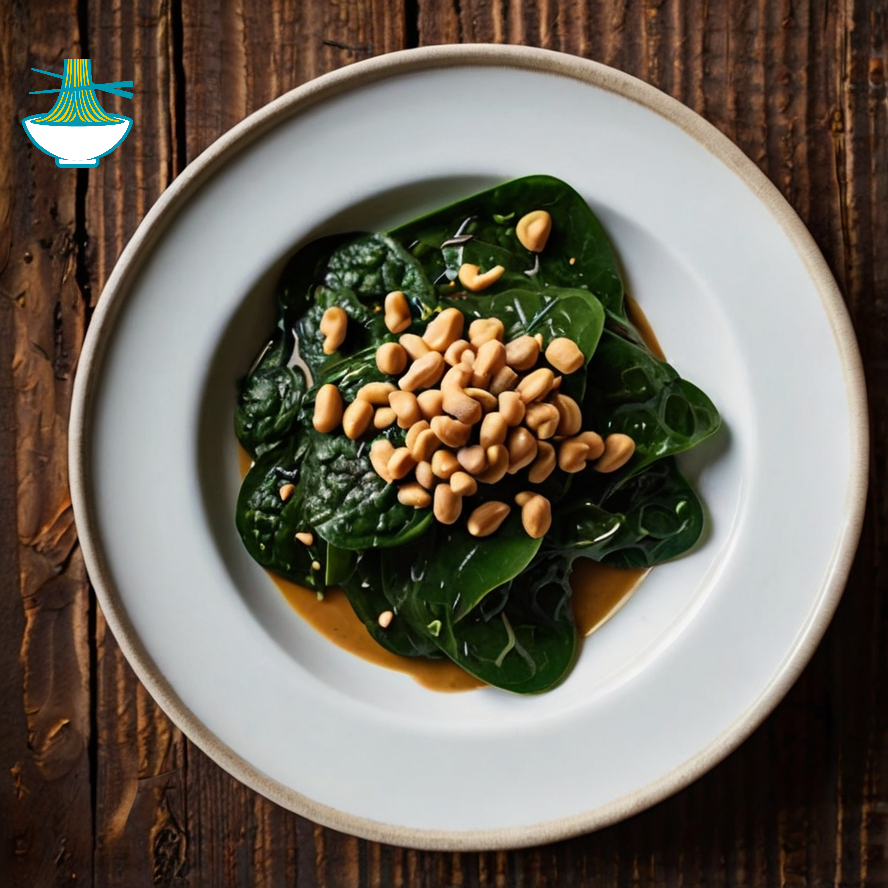Discover the rich flavors of Siyendle, a traditional dish featuring wild spinach cooked with creamy peanut butter or groundnuts. This nutritious recipe blends the earthiness of wild spinach with the nutty richness of peanuts, creating a delicious and satisfying meal. Perfect for those looking to explore unique African cuisine, Siyendle is both wholesome and easy to prepare. 
Ingredients:
- 2 cups wild spinach (or substitute with regular spinach if unavailable)
- 1/2 cup peanut butter or groundnuts (crushed)
- 1 onion, finely chopped
- 2 cloves garlic, minced
- 1 tomato, chopped
- 1 tablespoon vegetable oil
- Salt to taste
- 1/2 teaspoon black pepper
- 1/2 teaspoon ground paprika (optional)
Instructions:
Prepare the Wild Spinach: Wash the wild spinach thoroughly to remove any dirt or grit. If using regular spinach, rinse and chop it into bite-sized pieces.
Cook the Base: In a large pan, heat the vegetable oil over medium heat. Add the chopped onion and garlic, sautéing until the onion becomes translucent and fragrant.
Add Tomatoes: Stir in the chopped tomato and cook for an additional 3-4 minutes, allowing it to soften and blend with the onion and garlic.
Incorporate Peanut Butter: Add the peanut butter or crushed groundnuts to the pan, stirring until well combined with the tomato and onion mixture. If the mixture is too thick, add a small amount of water to achieve your desired consistency.
Add Spinach: Fold the wild spinach into the mixture, ensuring it is evenly coated with the peanut butter sauce. Cook for 5-7 minutes, or until the spinach is wilted and tender.
Season: Season with salt, black pepper, and ground paprika if desired. Stir well to incorporate the seasonings.
Serve: Serve the Siyendle hot, either as a main dish or as a flavorful side.
Enjoy this hearty and nutritious dish that brings together the vibrant flavors of wild spinach and the creamy richness of peanut butter!
Nutritional Values
Wild Spinach (2 cups)
- Calories: 41 kcal
- Carbohydrates: 7g
- Protein: 5g
- Fat: 0.5g
- Fiber: 2g
Benefits:
- Rich in vitamins A, C, and K, which support immune function, vision, and bone health.
- High in antioxidants and anti-inflammatory compounds.
- Provides iron and calcium, beneficial for blood health and bone strength.
Peanut Butter or Groundnuts (1/2 cup)
- Calories: 755 kcal
- Carbohydrates: 20g
- Protein: 33g
- Fat: 66g
- Fiber: 8g
Benefits:
- Provides healthy fats, including monounsaturated and polyunsaturated fats.
- High in protein, supporting muscle growth and repair.
- Contains vitamins and minerals such as vitamin E, magnesium, and potassium.
Onion (1, finely chopped)
- Calories: 44 kcal
- Carbohydrates: 10g
- Protein: 1g
- Fat: 0.1g
- Fiber: 2g
Benefits:
- Contains antioxidants like quercetin, which may help reduce inflammation.
- Provides vitamins C and B6, supporting immune health and metabolism.
- Adds flavor to dishes without adding significant calories. 
Garlic (2 cloves, minced)
- Calories: 4 kcal
- Carbohydrates: 1g
- Protein: 0.2g
- Fat: 0g
Benefits:
- Known for its potential cardiovascular benefits and anti-inflammatory properties.
- May support immune health and reduce the risk of certain chronic diseases.
- Adds robust flavor and depth to dishes.
Tomato (1, chopped)
- Calories: 22 kcal
- Carbohydrates: 5g
- Protein: 1g
- Fat: 0.2g
- Fiber: 1g
Benefits:
- Rich in lycopene, an antioxidant linked to reduced risk of certain cancers.
- Provides vitamins A and C, supporting skin health and immune function.
- Adds flavor and moisture to recipes.
Vegetable Oil (1 tablespoon)
- Calories: 120 kcal
- Fat: 14g (of which 2g is saturated fat)
Benefits:
- Adds richness and helps cook the ingredients.
- Provides essential fatty acids, though it's important to use in moderation due to its high calorie content.
Salt (to taste)
- Sodium: 2,300mg (daily recommended limit)
Benefits:
- Enhances the flavor of dishes.
- Essential for maintaining fluid balance and supporting nerve function.
- Should be used in moderation to avoid health issues related to high sodium intake.
Black Pepper (1/2 teaspoon)
- Calories: 6 kcal
- Carbohydrates: 1.4g
- Protein: 0.2g
- Fat: 0.2g
Benefits:
- Contains piperine, which may enhance the absorption of nutrients and have antioxidant properties.
- Adds a spicy kick and enhances the flavor profile of the dish.
Ground Paprika (1/2 teaspoon, optional)
- Calories: 6 kcal
- Carbohydrates: 1.4g
- Protein: 0.2g
- Fat: 0.2g
Benefits:
- Provides vitamin A, supporting vision and immune function.
- Adds color and flavor to the dish.
- Contains antioxidants that may help reduce inflammation.
In summary, this combination of ingredients provides a nutrient-dense, flavorful base for a dish. Spinach and tomatoes offer vitamins and antioxidants, while peanut butter adds protein and healthy fats. Garlic, onion, and paprika enhance flavor and provide additional health benefits. Salt and vegetable oil are used to season and cook the dish, with optional spices adding extra flavor.


Comments